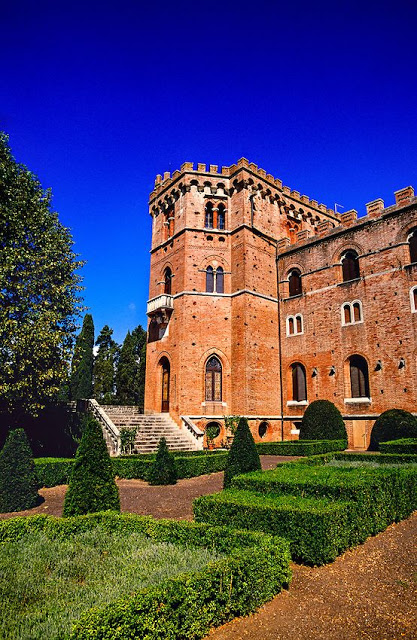Visiting Chianti On A Budget

For many, the Tuscan region of Chianti is the quintessence of rural Italy. It stretches from Florence in the north to Siena in the south, encapsulating an idyllic landscape of lush, rolling hills, ripe, fertile vineyards and solitary stone farmhouses. In short Chianti is an image of paradise, which makes it all the more difficult to believe that throughout the Middle Ages it was the scene of countless skirmishes, fought over by the very same two city-states that still straddle it to this day.
Just as Chianti lies geographically at the heart of Tuscany, Italy’s central region, so has it become established as the heartland of the Italy’s thriving viticultural industry. Chianti’s world-famous wine (Chianti Classico), its olive oil, and its cold meats and cheeses are just some of the locally grown regional produce that have earned Chianti its well-deserved gastronomic reputation and made it synonymous with the very best of Italian food.
At Roman Candle Tours, we’ve written this guide to help you explore and discover the universally beloved region of Chianti for yourself. Chianti might, thanks to its food, have earned itself a reputation for expensive cuisine and aspirational luxury, but this isn’t necessarily the case. We hope that after reading this you’ll see Chianti as easier and more economical to explore than ever and include it as a destination of choice on your next visit to Italy.
Getting to Chianti
Chianti doesn’t have an airport, so most visitors to the wine-producing region fly either into Florence or the busier (but further away) airports of Pisa or Bologna. Getting to Chianti from Florence is easy; the best and cheapest way to do so is to rent a car. From Pisa or Bologna, your best bet is to either rent a car directly at the airport or to take the train or coach to Florence and rent a car from there.
Chianti’s winding country roads can put some people off renting a car, especially if they’re not aux fait with the somewhat interpretative approach to driving many road users adopt in the Chianti countryside. But if you don’t feel entirely comfortable behind the wheel, you do have a number of other options for getting around the region.
The first is to hire a private driver for the day––a service Roman Candle Tours would be happy to arrange for you. This frees you up to explore Chianti at your leisure and reach some of the region’s more off the beaten path attractions, especially its many lesser-known towns and family-run wineries.
The other, slightly more limited option is to rely on the region’s public transport. Buses run fairly regularly between Florence and Greve in Chianti. The SITA bus stop is situated about 100 yards west of Florence’s main train station of Santa Maria Novella. Tickets, which can be purchased at the station kiosk, cost €3 one-way, and the journey takes just over an hour.
The first stop for most people visiting Chianti from Florence tends to be the small town of Greve in Chianti about 30 km south of the capital. Centred around the laid-back, triangular Piazza Matteotti, which is surrounded by reasonable restaurants and fresh produce food stalls, Greve in Chianti has enough to keep you entertained for a slow-paced morning or lazy afternoon spent sampling its gastronomic delights and unassuming trattorie (modest, family-run eateries).
Roman Candle Tours has already reviewed Greve’s star attraction, Antica Macelleria Falorni, in our article about Food and Wine Tasting in Tuscany. The historic butcher’s growing reputation is attracting more and more visitors to Greve in Chianti, but this rise in numbers is yet to negatively impact the eatery’s continued dedication to quality. Falorni is still the place to visit for an unbeatable platter of cured meats and cheeses, best enjoyed out on the piazza while washed down with a rich-bodied glass of Chianti Classico.
We can’t write about Chianti without mentioning Chianti Classico, and it’s here in Greve’s central piazza, every first weekend in September, that the annual Chianti Classico Expobrings the sleepy rural town to life. Wine stalls for more than 100 producers spill out across the square, many of which I was fortunate enough to sample when I went there a couple of weeks ago. Officially, the €10 tasting ticket allows you to try only seven. But on this particular Sunday, neither the punters or producers seemed to take notice, proving that in Italy, at least where good wine is concerned, some rules are made to be broken.
The wine that stood out most –– and this was earlier in the day, prior to when the wine impaired my judgement –– was the Chianti Classico Reserva produced by Monte Maggio. I’m no wine aficionado, and with little to distinguish one stall from another, I was drawn first and foremost to its label, a portrait of an Etruscan woman, which its producers took great pride in telling me symbolised their distant Etruscan heritage and deep-rooted ancestral connection to the land. ‘Full-bodied and flavoursome’ doesn’t do justice to this wine. To see what I mean, you must try it for yourself.
Monte Maggio Wine Tasting
I haven’t yet visited the vineyard of Monte Maggio, though it is on my list for things to do this autumn. But its salt of the earth owners and divine selection of wines made such an impression on me at the Chianti Classico Expo that I’m going to go out on a limb and say there are few better ways to spend an afternoon than sampling some of this small producer’s home cultivated wine and olive oil straight from the source.
Monte Maggio’s fully-immersive tasting and degustation tours, particularly reasonable at a maximum cost of €25 per person, guide you through the farmstead’s eight hectares of flourishing vineyards where they cultivate Sangiovese, Pugnitello, Merlot, Ciliegolo and Malvasia Nera grapes. As well as learning how to properly open, serve, and taste wine, you’ll have a chance at the end of the two-hour tour to try several of their all-organic wines and sample their selection of cold meats, cheeses, and olive oil.
For those of you wanting to get creative in the kitchen, Monte Maggio also offers cooking classes. Or if you want to slump back and relax, they can organise a light lunchof typical Tuscan products, all in the stunning setting of a hilltop farmstead which overlooks the folding hills of Chianti. Afterwards, take advantage of being in the heart of the region by visiting the nearby town of Radda in Chianti.
Radda in Chianti

Radda in Chianti is nothing if not atmospheric. Centuries of ravaging warfare—from the Middle Ages to WWII—have left a clear mark on the town to create a mishmash of medieval streets and tunnels, stretches of wall, and seldom visited churches—lovingly restored in recent years. Radda’s history goes back much further than the Middle Ages however. It began in earnest with the Etruscans, an indigenous people who were the precursors to the Romans and who started cultivating grapes in the area more than 2,300 years ago. Suffice to say that for today’s inhabitants, their technique is now as refined as their wine.
Radda in Chianti has some wonderful places to eat and drink. Highly recommended (though on the higher end price-wise) is the restaurant La Botte di Bacco—really, just check out the photos in the link. The restaurant is renowned for its gastronomic take on traditional Chianti cuisine. But if you’re looking for something simpler, and no less mouth-watering, try the slightly more budget-friendly, family-run L’Osteria Rifugio del Chianti.
Like much of Chianti, the countryside around Radda is a curious landscape. What were once fortifications against Florentine aggression have in recent years been converted into flouring farmsteads or residential villas. This makes a road tripthrough the region all the more rewarding, and explains a lot about why many movie directors in recent years have taken such historical interest in the area and its cinematic potential.
Movie-scene hunting in the Chianti area
This isn’t strictly speaking in Chianti but in the neighbouring Val d’Orcia on southern Sienese side of the region. But this similarly idyllic countryside is well worth seeing with your own eyes, not least because it’s renowned as the backdrop for some world-famous films. Many scenes from “The English Patient” were filmed here, namely at the agriturismo converted castle of Cosona and in the nearby town of Pienza.
 |
| Photo credit: Alamy |
So too was an iconic scene from Ridley Scott’s “Gladiator”; the region’s dreamlike, paradisiacal landscape was chosen as the set for Maximus’ Spanish farmstead (the one he frequently dreams about in which he runs his hands through wheat-fields). In fact, you can stay at the agriturismo farm where the scene was filmed, which is situated just outside the town of Pienza in the vicinity of Siena.
Gaiole in Chianti
Like many of its neighbouring settlements, for centuries Gaiole in Chianti was at the centre of the region’s theatre of war. Skirmishes between the respective rulers of both the Florentines and the Sienese left the area ransacked and its landscape populated by castles and strongholds. Yet out of darkness cometh wine, for it was in a castle just outside Gaiole in Chianti in 1872 that Baron Bettino Ricasoli came up with the recipe for the original Chianti Classico.
The castle in question, Castello di Brolio, is situated 20-minutes by car from the town of Gaiole in Chianti. Having long lost any practical need for its towering fortifications, its owners have converted much of their fortress into a thriving agriturismo business, complete with vineyards, a wine shop, a museum and even a restaurant. There is one aspect of continuity though: the castle is still inhabited by the same Ricasoli family who have owned the castle since at least 1141.
An hour-long tour of the castle grounds costs just €5 per person. The classic tour of the castle, its extensive vineyards, and a wine tasting session in one of the castle’s private rooms will set you back much more, €45 each, but is worth doing should your interest in Chianti’s history match your fervour for its cuisine. Castello di Brolio is only a 45-minute drive from Siena, the perfect place to finish up your trip around Chianti.
Wind down in Siena
Assuming you started from Florence, what better way to finish your trip around Chianti than at its southern border city of Siena. Roman Candle Tours runs a day tour of Siena and San Gimignano, leaving from Florence in the morning. Should you already be in Siena, though, or be visiting from nearby, we can meet you at a designated point and start from there.
Our itinerary includes the central Piazza del Campo, made famous by its bi-annual role as the horseracing track for Siena’s Palio (every July 2ndand August 16th) before moving on to the looming Torre del Mangia, the Cathedral of Siena—easily on a par with that of Florence—and one of Siena’s most imposing landmarks, the thirteenth century Basilica of San Domenico.
After wandering around Siena at our leisure, the tour moves on to the Sienese hill town of San Gimignano. Known as the “town of the fine towers,” for reasons that will become clear after you’ve seen it for yourself, San Gimignano’s rich Romanesque and Gothic architectural legacy has earned it recognition and protection as one of the region’s many UNESCO world heritage sites.
Our tour will take you through the best of San Gimignano’s heritage—including the breathtaking twelfth century church of St Mary of the Assumption—as well as the hill town’s equally enchanting side streets. At the end of the day, we’ll drive you back to Florence where you can set a few more days aside to explore the many wonders Tuscany’s renaissance capital has to offer.













